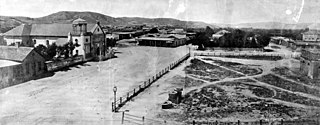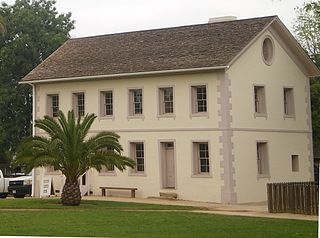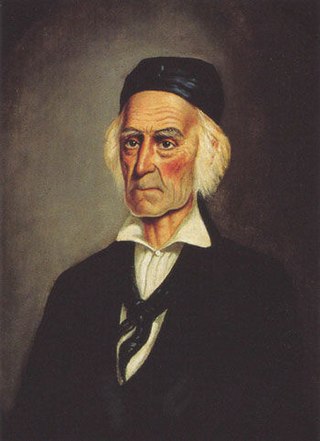Related Research Articles

Mission San Gabriel Arcángel is a Californian mission and historic landmark in San Gabriel, California. It was founded by the Spanish Empire on "The Feast of the Birth of Mary," September 8, 1771, as the fourth of what would become twenty-one Spanish missions in California. San Gabriel Arcángel was named after the Archangel Gabriel and often referred to as the "Godmother of the Pueblo of Los Angeles."

The Tongva are an Indigenous people of California from the Los Angeles Basin and the Southern Channel Islands, an area covering approximately 4,000 square miles (10,000 km2). In the precolonial era, the people lived in as many as 100 villages and primarily identified by their village rather than by a pan-tribal name. During colonization, the Spanish referred to these people as Gabrieleño and Fernandeño, names derived from the Spanish missions built on their land: Mission San Gabriel Arcángel and Mission San Fernando Rey de España. Tongva is the most widely circulated endonym among the people, used by Narcisa Higuera in 1905 to refer to inhabitants in the vicinity of Mission San Gabriel. Some people who identify as direct lineal descendants of the people advocate the use of their ancestral name Kizh as an endonym.
José María de Zalvidea was a Spanish Franciscan missionary. He was born at Bilbao, Vizcaya, Spain, and became a Franciscan at the convent of San Mames, Cantabria, on 13 December 1798. He joined the College of San Fernando de Mexico in 1804 and became a missionary to the California Native Americans in August 1805.
The Hahamog'na, commonly anglicized to Hahamongna and spelled Xaxaamonga in their native language, are a tribe of the Tongva people of California. Their language belongs to the Uto-Aztecan family.

El Pueblo de Nuestra Señora la Reina de los Ángeles, shortened to Pueblo de los Ángeles, was the Spanish civilian pueblo settled in 1781, which became the American metropolis of Los Angeles. The pueblo was built using labor from the adjacent village of Yaanga and was totally dependent on local Indigenous labor for its survival.

Rancho Los Encinos was a Spanish grazing concession, and later Mexican land granted cattle and sheep rancho and travelers way-station on the El Camino Real in the San Fernando Valley, in present-day Encino, Los Angeles County, California. The original 19th-century adobe and limestone structures and natural Encino Springs are now within the Los Encinos State Historic Park.

Los Encinos State Historic Park is a state park unit of California, preserving buildings of Rancho Los Encinos. The park is located near the corner of Balboa and Ventura Boulevards in Encino, California, in the San Fernando Valley. The rancho includes the original nine-room de la Ossa Adobe, the two-story limestone Garnier building, a blacksmith shop, a natural spring, and a pond. The 4.7-acre (1.9 ha) site was established as a California state park in 1949.

Rancho San Bernardino was a 35,509-acre (143.70 km2) Mexican land grant in present-day San Bernardino County, California given in 1842 by Governor Juan B. Alvarado to José del Carmen Lugo, José María Lugo, Vicente Lugo, and Diego Sepulveda. The grant included a large part of the San Bernardino valley, and encompassed present-day San Bernardino, Fontana, Rialto, Redlands and Colton.
The history of the San Fernando Valley from its exploration by the 1769 Portola expedition to the annexation of much of it by the City of Los Angeles in 1915 is a story of booms and busts, as cattle ranching, sheep ranching, large-scale wheat farming, and fruit orchards flourished and faded. Throughout its history, settlement in the San Fernando Valley was shaped by availability of reliable water supplies and by proximity to the major transportation routes through the surrounding mountains.
Alyeupkigna is a former Tongva-Gabrieleño Native American settlement in Los Angeles County, California.

Cahuenga ( or "place of the hill" is a former Tongva–Tataviam Native American settlement in the San Fernando Valley of Los Angeles, Los Angeles County, California. One source suggests kawe means mountain in Tongva language. Recent linguistic work suggests an alternative meaning of "place of the fox". The Tongva-language suffix -nga indicates place, and the suffix -bet or -bit indicates person from place; people from Cahuenga were recorded in mission registers as Capuebet.
Harasgna is a former Tongva-Gabrieleño Native American settlement in Los Angeles County, California.
Okowvinjha is a former Tongva (Fernandeño) Native American settlement in Los Angeles County, California. It was located near the Mission San Fernando Rey de España in the San Fernando Valley.
Sonagna or Sonanga is a former Tongva-Gabrieleño Native American settlement at or near what is now San Marino High School in Los Angeles County, California.
Politana or Apolitana was the first Spanish settlement in the San Bernardino Valley of California. It was established as a mission chapel and supply station by the Mission San Gabriel in the a rancheria of the Guachama Indians that lived on the bluff that is now known as Bunker Hill, near Lytle Creek. Besides the Guachama, it was also at various times the home for colonists from New Mexico and Cahuilla people. Its most prominent landmark today is the St. Prophet Elias Greek Orthodox Church on Colton Avenue, just southwest of the Inland Center Mall, in San Bernardino, California.
Víctor Pantaleón Linares (1807-1853), Californio, soldier, ranchero, majordomo of Mission San Luis Obispo, vecino and Juez of San Luis Obispo. Grandson of some of the earliest Spanish settlers of California, his second son Pio Linares was an infamous leader,, of a bandit gang in San Luis Obispo County in the 1850s.

Kaawchama, alternatively referred to as Wa’aachnga, was a significant Tongva village in the San Bernardino Valley located in what is now west Redlands, California. The village became referred to by the Spanish as the Guachama Rancheria in 1810 after a supply station was constructed at the village for Mission San Gabriel, which then became part of Rancho San Bernardino following the secularization of the missions in 1833.
Claudio López was a Californio politician who served as mayordomo of Mission San Gabriel Arcángel and Alcalde of Los Angeles.

Achooykomenga is a former settlement that was located at the site of Mission San Fernando Rey de España before it was founded in 1797. Prior to the mission's founding, in the 1780s, it functioned as a shared native settlement for an agricultural rancho of Pueblo de Los Ángeles that was worked by Ventureño Chumash, Fernandeño (Tongva), and Tataviam laborers.

The ranchos of Los Angeles County were large-scale land grants made by the governments of Spain and Mexico between 1784 and July 7, 1846, to private individuals within the current boundary lines of Los Angeles County in California, United States.
References
- 1 2 Hodge, Frederick Webb (1912). Handbook of American Indians north of Mexico, Part 2. The Internet Archive. Washington D. C.: Government Printing Office. p. 434.
- ↑ Bancroft, Hubert Howe (1884). The works of Hubert Howe Bancroft. The Internet Archive. San Francisco: A. L. Bancroft & Co. p 553, Footnote 5.
Santa Maria, Registro que hizo de los Parages entre San Gabriel 6 San Buenaventura, 1785, MS. Dated Feb. 3, 1796. The padre visited in this tour Cayegues ranchería, Simi Valley, Triunfo, Calabazas, Encino Valley with rancherias of Quapa, Tacuenga, Tuyunga, and Mapipinga, La Zanja, head of Rio Santa Clara, and Mufin rancheria. The document is badly written and I also suspect badly copied, and the names may be inaccurate. In some spots the pagans cultivated the land on their own account. Corporal Verdugo owned La Zanja rancho. Governor's order of July 23d, in Prov. Rec., MS., iv. 19. In St. Pap., Miss., MS., ii, 55-6, it is stated that Santa Maria made an unsuccessful survey.
- ↑ Reid, Hugo (1926). "The Indians of Los Angeles County". HathiTrust. p. 69 of the file, but p. 55 of the book. hdl:2027/uc1.$b59340 . Retrieved 2024-03-06.
The principal ranchos belonging at that time to San Gabriel were San Pasqual, Santa Anita, Azusa, San Francisquito, Cucumonga, San Antonio, San Bernardino, San Gorgonio, Yucaipa, Jurapu, Guapa, Rincon, Chino, San Jose, Ybarras, Puente, Mission Viga, Serranos, Rosa Castillo, Coyotes, Saboneria, Las Bolsas, Alamitos and Cerritos.

